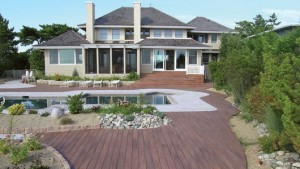
How to build a deck, advice from a professional

For low-maintenance, non-slip performance, surface composites are a great choice, because they don’t rot or splinter and need no waterproofing or sealing.
As founder of Garden Structure, Lawrence Winterburn knows how to build a deck that lasts.
When it comes to how to build a deck, the first step, he says, is to pick the right decking material from a sea of choices that includes composites, exotic hardwoods and the newer “virgin vinyls.” All of these choices perform well when properly installed. But make a few common construction errors, and those same products may fail quickly.
Asked to pick his favorite decking materials, Winterburn chose classic red cedar and redwood. Both species are naturally resistant to rot and insects and less likely to cup, warp or twist than other wood species. Pressure-treated Southern pine is another, more economical favorite Winterburn admires for its tight grain and strength.
For low-maintenance, non-slip performance, surface composites are a great choice, because they don’t rot or splinter and need no waterproofing or sealing.
Although the upfront cost of composites may be more than treated wood, a homeowner will save a significant sum on upkeep over the life of the deck. Some manufacturers even guarantee products for as long as 15 years.
The downside is that some composites may stain, fade, or attract mold or mildew. “My advice about composites would be to read the manufacturer’s instructions closely,” says George Drummond, whose company, Casa Decks in Virginia Beach, Virginia, works almost exclusively with composites.
“When clients tell you how beautiful your workmanship is, what they are really seeing is the decking material. It’s very important that you use a good product and install it correctly.”
How to build a deck
With so many new products on the market, there’s always a learning curve with how to build a deck. “The number one mistake I see in the field recently is using the wrong deck fasteners with ACQ lumber. I’ve seen bolts rot off in three years,” says Winterburn, referring to woods treated with alkaline-copper-quaternary preservative.
The chemicals in ACQ lumber don’t contain the controversial arsenic in CCA-treated wood, now phased out in the United States. Yet the high copper content in ACQ quickly rusts common steel. When working with the new ACQ lumber, look for hardware that is double-galvanized.
The USDA Forest Service recommends choosing fasteners with the thickest protective coating, such as hot-dipped products. Stainless steel is another good choice. In addition, deck flashing should be either galvanized steel or copper—aluminum is out because it corrodes quickly when touching copper. Of course, even the “right” deck fasteners will fail if not installed properly. Here are solutions to more common decking problems.
Problem: Improper fastening
A deck needs to be firmly fastened to the house’s framing. According to one study, 90 percent of deck collapses are caused when the connection from the ledger to the house fails.
Solution
“There are 10 different acceptable methods for fastening depending on what the cladding is,” Winterburn notes. “However, for second-floor decks just about anywhere in North America, you are going to need to bolt right through to the blocking or rim joists.”
Problem: Moisture
Controlling moisture plays a role in every aspect of deck construction. Wood that is not properly dried and finished is likely to splinter, crack, cup and warp down the road.
Solution
Starting with job preparation, dry lumber to a moisture content of less than 20 percent prior to installation, regardless of wood species. (Pressure-treated wood is frequently delivered with a moisture content closer to 35 percent.) After drying, prestain the lumber—including all edges—before installation.
Problem: Poor drainage
The next major concern is constructing the deck to drain properly. Water intrusion into a home can occur once the building’s envelope is penetrated by bolts.
Solution
To keep moisture out, caulk all holes in the building’s envelope and install flashing prior to attaching the deck. A similar drainage issue is proper spacing of decking material, and Winterburn recommends 3/16-inch spacing because it allows the top of the joist to dry. (Synthetic materials will expand and contract, so builders should check installation recommendations to be sure.) Flashing that goes over the joists will work well to prevent moisture from sitting between the decking and the joists.
Problem: Improper underside prep
The best contractors also pay attention to what’s under the deck. Problems commonly occur when this area is improperly graded or poorly ventilated. If the top of the deck can dry while the underside remains damp, all your good work will deteriorate quickly.
Solution
Prepare the ground so that it slopes away from the house, then cover it with polyethylene plastic sheeting, topped with gravel.
Problem: Inconsistency in deck material
According to Veranda and other suppliers, wood and other deck materials can vary widely in appearance, even if they are from the same timber species.
Solution
Veranda recommends that deck builders try to purchase all wood at one time so that there is consistency in grain and tone.
According to Millstead, “Construction lumber is graded to ensure that it consistently meets certain strength standards. Grading each piece of lumber makes it easier for builders to select the appropriate strength lumber for a job.”
What’s the best way to ensure that a deck maxes out its life span? “Long-lasting decks are all about over-building,” Winterburn notes. “Our company routinely builds 20 percent heavier than code—and after 20 years, our decks still feel strong.”

